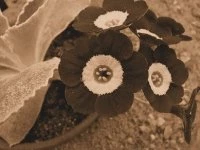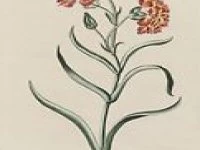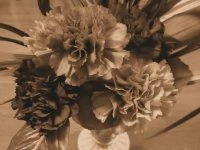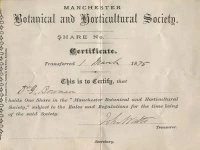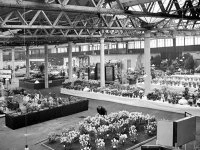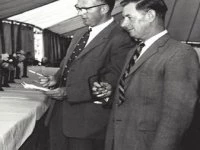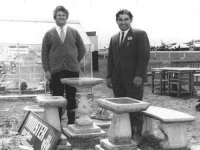Flower Shows
There are two different types of flower show – the specialist and the general. The specialist shows date back a long time – no-one is quite sure how long – but the general shows really started in the 19th century.
The flower shows in the 18th century are usually called 'florists' feasts'. This is because they were held at public houses, and to make it financially worthwhile for the landlord, competitors and visitors would stay for a meal. In fact, in Tetsworth (Oxfordshire) in 1755, the advertisement for the carnation show said that anyone wishing to see the plants without partaking of dinner would have to pay one shilling towards the cost of the following year's event.
These florists' feasts were for carnations, pinks, tulips, ranunculus, hyacinths, auriculas and polyanthus. These were all known as 'florists' flowers' and different parts of the country were famous for specific plants. Glasgow was known for pinks, Manchester for auriculas, although anyone who was keen probably grew several different types of plants – after all, the shows would be at different times of the year depending when the flowers were in bloom. These plants were chosen because they produced variable seed, so clever cross-pollination gave rise to lots of new varieties that were in great demand and expensive. In 1767 Thomas Gorton offered some of his new varieties for sale – 'Earl of Chatham' and 'Liberty' were each priced at one guinea! Plants were given the names of their raisers, like 'Gorton's Champion' – this was helpful if two people called their new plant the same name.
At each show, there was usually an overall prize, as well as prizes for different classes. For Auriculas, the classes were Green-edged; Grey-edged; White-edged and Selfs (where the flower was all one colour). Carnations were 'bizarre' (or 'bizard'), which had two colours on a white ground, or 'flakes', which were white with distinctive markings in just one colour, or picotees (white or yellow with a , coloured edge). Some tulips were called bizards, too. These had a yellow ground, whereas bybloemens had a white ground. Tulip bulbs were infected with a virus which meant that the colours broke, giving them lovely markings known as 'flames' or 'feathers' depending upon the effect.
The overall prizes at florists' feasts were usually, but not always, a piece of silver – like a silver teapot, but there were sometimes what seem now to be very strange prizes. In 1768 in Ipswich the first prize at the tulip show was a hat valued at 25 shillings.
During the 19th century a new set of flowers became known as florists' flowers, because they too gave rise to lots of variable seed. These included pansies, geraniums, roses, verbenas, petunias, fuchsias and dahlias. William Caldwell sold dahlias he had raised himself: 'Caldwell's Gloria Mundi' and 'Caldwell's Purple Globe' dahlias. Shows just for these plants were sometimes held, although they were also found in the general shows.
Not all shows were for just one type of plant. In the early 18th century in Newcastle upon Tyne there was a Society of Florists and Botanists and there are newspaper reports from around 1725 for Carnation shows, which also included the showing of a variety of fruits, and even 'exotic plants'.
From around 1820 general flower shows became popular as Floral and Horticultural and/or Botanical and Horticultural Societies were started in the big towns. In Manchester there was one of each and they each held several shows every year. The Floral and Horticultural Society paid more attention to the florists' flowers than did the Botanical and Horticultural Society. The shows were an important event in the social calendar, but they could be a bit of a battle ground. In the 18th century the florists' feasts were open to everyone who was keen on growing those particular flowers. In the 19th century the newly rich middle classes wanted to show off their wealth rather than their ability to raise new varieties of flowers. So plants which could only be grown in hothouses became very fashionable – like the Erica: lots of new South African species of this had begun to arrive at the end of the eighteenth century.
After a few years, the role of nurserymen at these general shows changed. At first they entered the competition on the same basis as everyone else, but soon they had their own classes and sometimes they showed plants without entering the competition.
At least one William Caldwell was a florist and won prizes at an Auricula show held in May 1824 and a Carnation Show in August the same year. These shows were held at The Volunteer pub in Knutsford, where Mr. Roberts was the landlord. At the 1825 Auricula show, William Caldwell won the overall prize (a kettle) and also 10 other prizes (out of a total of 24). These auriculas included 'Caldwell's Knutsford Lass' and three of his new seedlings.
We have found several references in newspaper reports to Caldwell's at flower shows between 1875 and 1938. Sometimes the business was there as a competitor, other times as an exhibitor and sometimes just providing a display of plants which would hopefully encourage new customers to the nursery.
Caldwell's attended the Bolton Flower Show for some years in the 1870s. There they won a 1st prize in the nurserymen's class; another 1st for foliage plants, but in 1876 only a 3rd prize (£4) for a collection of 15 plants. At Cheadle, in 1886 they were awarded 2nd prize in the nurserymen's class for a 'group of plants in pots not exceeding 10 inches in inside measurement'. At the Manchester Botanic Gardens in late Spring 1904 they won 2nd prize (again in the nurserymen's class) for the 'best collection of hardy herbaceous and Alpine plants, not less than 50, arranged for effect'. In 1928 Caldwell's won 1st prize at Hanley for a display of aquatic plants arranged around a pool of water.
Often the displays were not for competition, but still warranted a medal. Caldwell's were successful several times at the Botanic Gardens in Manchester. They won a silver medal for herbaceous Alpine plants (Chrysanthemum Show,1901); a Certificate of Merit for a miscellaneous collection of flowers (Rose Show, 1903); a silver medal for miscellaneous plants (Rose Show, 1905); and an award of merit for their trade exhibition (Chrysanthemum Show, 1905).
Although the Botanic Gardens closed down in 1907, there were other places for Caldwell's to exhibit. They won a silver medal for their trade display in 1913 at the South Manchester and District Horticultural Society show; two gold medals at Alderley Edge (once in 1924 and again in 1935) and in 1938 the Bramhall, Cheadle Hulme and Woodford Agricultural and Horticultural Society awarded Caldwell's a gold medal for their herbaceous collection.
Once it was Caldwell's providing the prizes. In 1897 at the Styal Floral and Horticultural Show, they offered special prizes for sweet peas, which were won by J. Rowlinson and A. Cooper of Styal.
Sometimes Caldwell's simply provided the plants as a display. At the Worsley Agricultural and Horticultural Show in 1876 they had a 'splendid display of stove and greenhouse plants' in the main tent, and at the Manchester Botanical Society in 1878 they exhibited 'some fine stove and greenhouse plants'. Nine years later, at the International Horticultural Exhibition in Manchester (1887) Caldwell's display of evergreen trees and shrubs was ranged along the right hand side of the broad walk leading past the pavilion. In 1896 they provided a display of cut flowers, including 45 varieties of sweet peas, and a collection of roses at the show in Bowdon and in 1903 they had a 'variety of choice roses, hardy herbaceous blooms, &c.' at the Marple and District Horticultural Society. In 1910 the nursery sent groups of flowers and plants, not for competition, to the flower show at Mobberley.
Caldwell's Nurseries were founder members of the International Garden Centre Association (IGCA). In 1985 the IGCA decided to have a hanging basket display at the Royal Horticultural Society's Chelsea Flower Show. Frank Passant, Chair of the NW region of IGHA for four years, contacted the manager of the Ford garage in Knutsford and suggested that the best vehicle for transporting Caldwell's hanging baskets to Chelsea would be the new Ford Granada Mark III. The manager agreed and provided the car for Caldwell's so gaining publicity for both companies! Pictured are the manager of the Ford Garage handing the keys to Frank Passant with Mrs Osborne and Carol Chapman holding the hanging baskets. The date of this photograph has been identified through the car registration!
You can hear more about Caldwell's and flower shows in the oral histories – memories.

